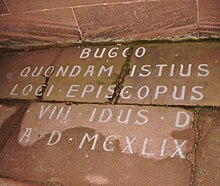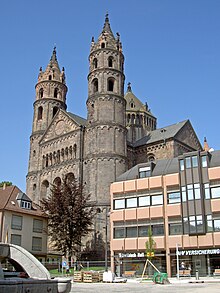Burchard II (Worms)
Burchard II. , Also Bucco or Buggo († December 6, 1149 ) was an important bishop of Worms and had today's east work of Worms Cathedral built.
Origin and family
He came from the noble family of the Lords of Ahorn , which died out in 1271 and who had their ancestral seat at the castle of the same name in Upper Franconia . They were feudal people of the Bamberg diocese . Burchard's father had the same name as him, his mother's name was Judith. He had the brothers Heinrich, Luitpold and Poppo, of which Heinrich became known because of his visions of purgatory , which were handed down in writing .
Live and act
First period of the episcopate
After the death of Worms Bishop Adalbert II († 1107) the diocese remained vacant for a few years. In 1115 Emperor Heinrich V decided to appoint his court chaplain Burchard von Ahorn as bishop. This was also provost of the Aschaffenburg Abbey of St. Peter and Alexander . Various chroniclers still report on an Arnold von Beuern whom some of the Worms canons simultaneously elected counter-bishop, but who voluntarily renounced all claims after five years.
Adalbert I of Saarbrücken , who had been an enemy of the Kaiser since 1112 because of his imprisonment, refused to consecrate Burchard as the competent Archbishop of Mainz . Only after there had been disputes between the Emperor and Bishop Burchard and the latter switched to the Archbishop's side, the church could be appointed. But from this point on, as the emperor's enemy, he was no longer allowed to enter his diocese seat of Worms and stayed mostly in Mainz . In 1125, with the death of the ruler, he returned to Worms.
Second period of the episcopate
In his second phase of government, Burchard was to become an important pastor in the history of the diocese. In 1125 he consecrated the Groß-Frankenthal collegiate church and on December 26, 1132 buried its founder Erkenbert von Frankenthal, who was already venerated as a saint .
As early as 1130, the bishop began to gradually tear down the cathedral built under his predecessor Burchard I and replace it with a new one , presumably due to severe structural damage . This is how the entire east work of the Worms Cathedral was created under him, with towers and crossing dome as we know it today. The nave and westwork were built under his successors, Konrad I and Konrad II .
On March 7, 1138 Burchard was in Koblenz at the election of King Konrad III. involved, with whom he subsequently developed a closer relationship and often stayed at his court.
On June 30th of that year he consecrated the altar of the Gotthard Chapel at Mainz Cathedral .
In 1141, Bishop Burchard consecrated the Höninger monastery church , some of the ruins of which have survived.
In 1142, on his personal initiative, the Cistercian monastery Schönau was founded, which he particularly loved.
In 1145 he also handed over the Hohenstaufen Hofgut Lobenfeld, a fief of the childless Meginlach von Obrigheim , with the consent of Konrad III, to the Frankenthal monastery to set up a branch. This resulted in the Lobenfeld Monastery , of which significant remains still exist.
Burchard II died on December 6, 1149 and was buried at his own request in his Schönau Foundation. The historians Friedrich Zorn (1538–1610) and Johann Friedrich Schannat († 1739) pass on his epitaph inscription there, which was written by the Speyer bishop Günther von Henneberg . The burial place is no longer preserved. Next to the southwest corner of the Worms Cathedral, in the floor area of the former cloister , a simple memorial inscription also reminds of him; here he is called Buggo .
Daniel Ludwig Wundt (1741–1805) calls Burchard II “ great through virtues among the prelates of his time ”. Friedrich Wilhelm Ebeling wrote about him in 1858: “ ... an active, determined and insightful man. He did great services to the clergy and spiritual institutes. "
He is often confused with Bishop Burchard I , who had the predecessor of the Worms Cathedral built.
literature
- Hans Ulrich Berendes: The bishops of Worms and their bishopric in the 12th century . Diss., University of Cologne 1984, pp. 49-89.
- Friedrich Wilhelm Ebeling: The German bishops until the end of the sixteenth century. biographical, literary, historical and church statistics. Volume 2. Wigand, Leipzig 1858, p. 532 .
- Friedhelm Jürgensmeier : The diocese of Worms. From Roman times to its dissolution in 1801 (= contributions to the history of the Mainz church. Vol. 5). Echter, Würzburg 1997, ISBN 3-429-01876-5 , pp. 29-35.
- Johann Friedrich Schannat : Historia Episcopatus Wormatiensis. Volume 1. Varrentrapp, Frankfurt am Main 1734, pp. 350–354 .
- Friedrich Zorn: Worms Chronicle (= library of the literary association in Stuttgart. 43). With the additions of Franz Berthold von Flersheim, edited by Wilhelm Arnold . Litterarischer Verein, Stuttgart 1857, pp. 50–51 .
Individual evidence
- ↑ Heinrich Boos : History of the Rhenish urban culture from its beginnings to the present with special consideration of the city of Worms. Volume 1. Stargardt, Berlin 1897, p. 398 , (detail scan on the date of death).
- ↑ Robert Plötz, Hedwig Röckelein : The vision of Heinrich von Ahorn and the monastery of St. Georgenberg. In: Klaus Herbers (ed.): City and pilgrims. Social communities and cult of saints (= James studies. 10). Gunter Narr, Tübingen 1999, ISBN 3-8233-4010-7 , pp. 29–68, especially pp. 49–51, (digital scan of the family)
- ↑ Franz Machilek: piety of the late medieval nobility. In: Klaus Schreiner , Elisabeth Müller-Luckner (Ed.): Lay piety in the late Middle Ages. Forms, functions, political-social contexts (= writings of the Historisches Kolleg. Colloquia. 20). Oldenbourg, Munich 1992, ISBN 3-486-55902-8 , pp. 157-190, here pp. 161 and 162, (digital scan) .
- ↑ Worms Cathedral web portal ( Memento from March 2, 2017 in the Internet Archive )
- ↑ Website for dedicatory inscription
- ↑ Website on the Gotthard Chapel in Mainz ( Memento from February 2, 2015 in the Internet Archive )
- ↑ PDF document on Schönau Monastery
- ↑ PDF document on the Lobenfeld Monastery
- ^ Daniel Ludwig Wundt : Magazine for the church and scholarly history of the Electorate of the Palatinate. Vol. 1, 1789, ZDB -ID 2415712-0 , p. 42 .
| predecessor | Office | successor |
|---|---|---|
| Adalbert II. |
Bishop of Worms 1115–1149 |
Konrad I. |
| personal data | |
|---|---|
| SURNAME | Burchard II |
| ALTERNATIVE NAMES | Bucco II .; Buggo II .; Burchard of Maple |
| BRIEF DESCRIPTION | Imperial chaplain, Bishop of Worms |
| DATE OF BIRTH | 11th century |
| DATE OF DEATH | December 6, 1149 |


